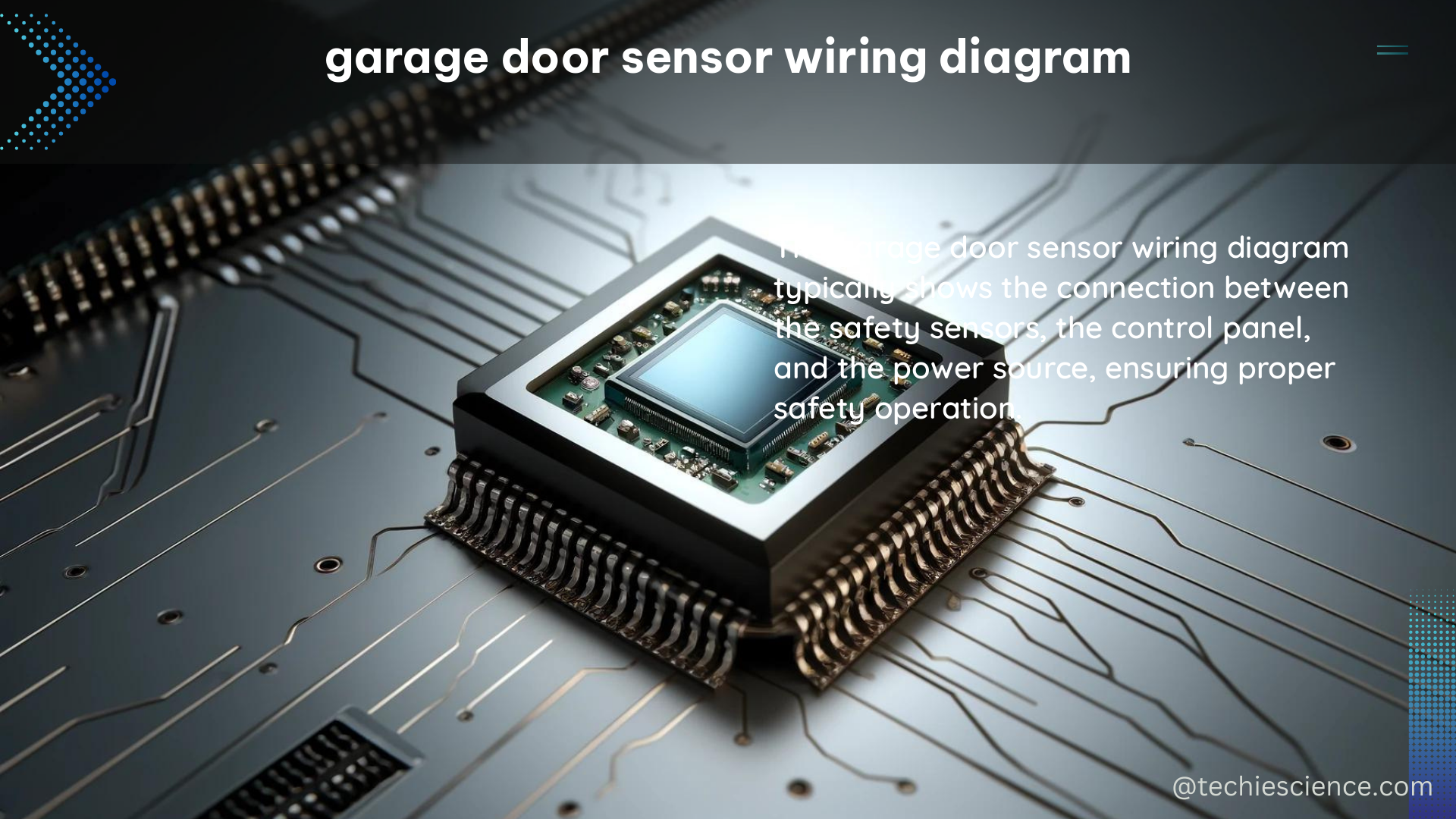The garage door sensor wiring diagram is a crucial component in ensuring the safe and efficient operation of your garage door system. This comprehensive guide will delve into the technical details, best practices, and step-by-step instructions for properly wiring your garage door sensors, empowering you to tackle this project with confidence.
Understanding the Basics of Garage Door Sensor Wiring
Garage door sensors are designed to detect the presence of obstructions in the door’s path, triggering the opener to stop and reverse the door’s direction. The wiring diagram for these sensors typically involves the use of 22-gauge or 18-gauge wire, with color-coding to help maintain polarity.
Wire Specifications and Routing
The wire used for the garage door sensor wiring should be run between the sensors, the garage door opener, and the control panel. It is recommended to use thermostat wire with an outer jacket for added protection and backup in case of damage or failure. The sensors themselves require two wires, which should be tied together and wired to the opener as per the installation instructions.
Sensor Voltage and Operation
In terms of technical specifications, the sensors typically operate on a voltage range of 10-12 volts DC. When the sensors detect an obstruction, they send a signal to the opener, causing it to stop and reverse the door’s direction. The sensors should be aimed and adjusted properly to ensure that the beams meet up and the door operates correctly.
Preparing for a DIY Garage Door Sensor Wiring Project

Before embarking on your DIY garage door sensor wiring project, it is essential to gather the necessary tools and materials, as well as familiarize yourself with the manufacturer’s instructions.
Tools and Materials Needed
- 22-gauge or 18-gauge wire (thermostat wire with outer jacket recommended)
- Wire strippers
- Wire connectors or wire nuts
- Electrical tape
- Voltage tester or multimeter
- Ladder or step stool (for accessing the sensor locations)
Identifying and Labeling Wires
One of the critical steps in a successful DIY garage door sensor wiring project is properly identifying and labeling the wires. It may be helpful to use a wire tracer to determine which wires are related to the garage door sensors and label the ends before drywall is installed.
Step-by-Step Guide to Garage Door Sensor Wiring
Follow these step-by-step instructions to ensure a proper and safe installation of your garage door sensor wiring:
-
Disconnect Power: Ensure that the power to the garage door opener is turned off before beginning any wiring work.
-
Locate Sensor Positions: Identify the locations of the garage door sensors, typically mounted on either side of the door opening.
-
Run the Wiring: Using the 22-gauge or 18-gauge wire, run the wiring from the sensor locations to the garage door opener and control panel. Ensure that the wiring is properly routed and secured.
-
Connect the Sensors: Connect the two wires from each sensor by twisting them together and securing them with a wire connector or wire nut. Then, connect the sensor wires to the corresponding terminals on the garage door opener, as per the manufacturer’s instructions.
-
Test the Sensors: Once the wiring is complete, use a voltage tester or multimeter to ensure that the sensors are receiving the correct voltage (10-12 volts DC) and that the door is responding correctly to the sensor signals.
-
Adjust Sensor Alignment: Carefully adjust the sensor positions to ensure that the beams are properly aligned and the door operates smoothly.
-
Secure and Conceal Wiring: Secure the wiring using cable clips or staples, and conceal it within the wall or along the ceiling, if possible, to maintain a clean and professional appearance.
-
Restore Power and Test: Restore power to the garage door opener and test the full functionality of the system, including the sensors, to ensure everything is working as intended.
Troubleshooting and Maintenance
In the event of any issues with your garage door sensor wiring, it is essential to follow a systematic troubleshooting process to identify and resolve the problem.
Common Issues and Troubleshooting
- Sensor not detected by the opener: Check the wiring connections, sensor alignment, and voltage supply.
- Door reverses unexpectedly: Ensure that the sensors are properly aligned and not obstructed.
- Intermittent sensor issues: Inspect the wiring for any damage or loose connections.
Maintenance and Preventive Care
Regularly inspect the garage door sensor wiring and components to ensure their continued reliable operation. This includes checking for any signs of wear, damage, or loose connections, and making necessary adjustments or replacements as needed.
By following the comprehensive guide outlined in this blog post, you can confidently tackle your garage door sensor wiring project and ensure the safe and efficient operation of your garage door system.
Reference:
- Garage Door Wiring Type for Both Opener and Sensors?
- How to wire safety sensors to a garage door opener
- How do I properly identify which sensor wires are which for my pre-wired garage
- bypassing/emulating garage door opener safety sensors
- Diagnosing garage door sensor problem from technical viewpoint

The lambdageeks.com Core SME Team is a group of experienced subject matter experts from diverse scientific and technical fields including Physics, Chemistry, Technology,Electronics & Electrical Engineering, Automotive, Mechanical Engineering. Our team collaborates to create high-quality, well-researched articles on a wide range of science and technology topics for the lambdageeks.com website.
All Our Senior SME are having more than 7 Years of experience in the respective fields . They are either Working Industry Professionals or assocaited With different Universities. Refer Our Authors Page to get to know About our Core SMEs.